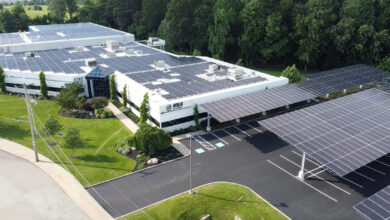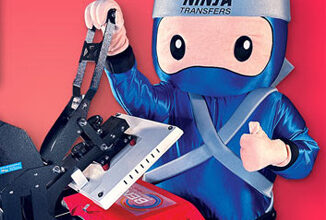Shop Snapshot: Awesome Graphics
Rachel Stuckey's sublimation shop, Awesome Graphics, took off after attending THE NBM SHOW back in 2007. More on her story and why she'll be back again this year.
When Rachel Stuckey began checking into starting a business in early 2007, she thought it would be something she’d do part-time in a spare room at her home in Hobbs, New Mexico. That was when she first heard about sublimation printing, which seemed like a simple home-based craft that would be fun, creative – and hopefully, she’d end up with a little extra cash. She planned to start by selling personalized coffee mugs to friends and neighbors. She figured she’d just need a sublimation printer, a heat press, and some mug blanks, all of which would fit nicely in the spare room on some shelves and a work table.
It would be a fun, part-time hobby business.
THE SET UP
That was in 2007, the year that her mother-in-law suggested she check out a trade show to see the latest equipment – which she did. She attended THE NBM SHOW that spring and while there, she took some classes on running a business, graphics, art, sublimation, and digital art systems. She got advice from people who had been in business; she shared stories with others who were starting out; and when she got back to Hobbs, she had her new set-up: an Epson 4000 sublimation printer and heat press, along with some graphics software and blank mugs.
And then she started telling friends and neighbors what she had to offer.
And then orders started coming in.
And then she needed to recruit her sons, Hunter and Trent, to help after school.
And then she needed to hire a part-time helper.
In no time, the spare room was crowded, laden with stacks of blank mugs, ink, packaging, and other supplies, as was the sun room and living room. The solution was in the back yard, where an 850-square-foot two-car shop stood that her husband, Loren, used to work on cars and other projects. They decided to turn half of it into a graphics shop; but when a manual screen printer arrived a few months later, the business took up the whole shop, and it continued to grow like that for two more years.
Having the shop behind the house was convenient, but also interrupted home life and created a traffic situation with customers constantly coming and going. So, they found an 800-square-foot retail location, which did allow for some separation between the business and home. “It was inexpensive, but difficult because we couldn’t fit all the equipment there,” Loren remembers, “and we still were going back and forth between there and the house.”
But it worked for almost another year.
Meanwhile, Loren had been in touch with the owner of an empty 4,000-square-foot retail/commercial building who was ready to sell. They worked out a deal and suddenly the shop finally had some real space.
That was in 2011.
SMALL STEPS, BIG STEPS
It took them a few months to get the building set up enough to start moving equipment, which by then had grown to include a digital printer, laminator, sublimation printer, cutter/plotter, and a manual T-shirt screen printer.
New equipment acquisition has always been based on what’s needed to fill a demand. “With sublimation, it started as a small hobby-type business,” says Rachel, who attended a second and a third NBM trade show within two years. “We grew from educating ourselves about different equipment and different production processes. By the third show, I was looking at large-format printing and graphics and sublimated T-shirts,” she says.
And then, people were wanting more and bigger quantities of printed T-shirts.
“Sublimation is a hard way to satisfy an order of 100 printed T-shirts,” says Loren, who, by the second year, was coming home after his job at the power plant and working several more hours in the graphics shop, “and we were getting a lot of requests for those.” So, they looked into screen printing and got a good deal on a show floor model at the next show they went to. Then embroidery was added because a lot of customers requested that too. “It took a while to grow that into the business,” Rachel recalls, “but now we work at that as well.”
“We had a smaller printer that was also a plotter but couldn’t use that to satisfy all the jobs we needed it for, so we traded it in and got a larger plotter and a larger printer so both could be working at the same time,” Loren says. Another big step was going from a manual to an automatic M&R T-shirt press three years ago.
These days, the work is diverse, somewhat seasonal, and to keep things interesting, changes just about every month. “Sometimes it’s labels, small signs, banners, and decals, so the digital printer gets used a lot,” Rachel says. “Then suddenly it will flip and we’re doing embroidery.”
Or just as suddenly there’s an order for 300 printed T-shirts.
Which leads to why some equipment is in the shop and other equipment is not. For example, at the power plant, Loren held certifications in welding and machining, so it seemed to make sense for him to use those skills to fabricate things like screen printing frames or metal sign frames in house. But it turned out another shop nearby could do that faster and cheaper, which allowed him to focus on other things. It’s a similar story with engraved plaques and awards, which can be easily outsourced. “We don’t get a whole lot of requests for those, so it’s not worth buying that equipment,” Loren says.
On the other hand, it is worth buying equipment to fill the big requests. So, when a screen printer the next town over was having a hard time keeping up with T-shirt orders, it was time to invest in a screen printing press; when an embroidery shop that was two hours away could no longer keep up with the orders, it became time to bring an embroidery system in house.
LEAP OF FAITH
While in the beginning, Rachel thought of it as a hobby that could produce a little extra money, after a few years, Loren started entertaining the idea of leaving his job at the power plant to work full-time at what was becoming a full-service graphics and print shop. “We decided to step up the business and grow it more than we originally intended,” Loren says.
Meanwhile, Rachel’s uncle advised against making it a hobby: “Make it a business,” he said. They did, and for a while Loren worked 12 to 16 hours a day and Rachel didn’t take a salary. “We invested everything back into the business and even some of my income from the power plant for several years,” Loren says.
It was a leap of faith, but in 2014 Loren retired from the power plant and began working full-time in the graphics shop. “There are things you forget you’re going to lose,” says Rachel. “You not only lose a monthly income, but you also lose health insurance and other insurances, so you need to figure out ways to compensate for that. Sick days? Vacation? What is that?”
Along with all the printing and fabrication equipment and hardware, the business also relies heavily on graphic programs, estimating software, and bookkeeping. And included on the list of ‘Things important to growth of the business,’ was another useful setup – a server.
“When we started, we had one computer and everything was on it. Eventually you get a bottleneck so you get another computer, but those computers don’t communicate, so you have to transfer files by carrying the file from one computer to the next. My father talked us into putting in a server because we were carrying files back and forth between computers on little flash drives,” Loren says. “He built that first server for us and we were on that for about four years. It made life so much more amazing.”
ABOUT THE FUTURE
After growing the business for 10 years, both Loren and Rachel anticipate growth to continue for some time yet to come. Part of that means they’ll be doing everything they can to stay current with the latest technology, and both say trade shows like THE NBM SHOW are the best way to see what’s out there, network, and hone a few skills, so they’re planning another trip this year to see what’s new.
“To succeed you have to be willing to learn and to grow,” Rachel says, “so we’ll be looking for more information.” And the information won’t just be for Loren and Rachel. In 2016, they decided for the first time to take employees to THE NBM SHOW and got them involved in the education program. “It really helps our employees gain a different perspective on our business,” Rachel says. “They also had great experiences visiting with people from other businesses. They said that they felt appreciated and valued, and that benefitted us.”
There’s still plenty of room in the shop to grow, but there’s still plenty to do to keep up with the work that continues to come in. Which will mean that besides their son, Trent, who now works full-time in the shop, along with two other full-time employees, Elvia and Lauren, they’ll be hiring a couple more people to keep things moving.
Future growth might not so much mean adding more equipment as expanding their use of the equipment and their market reach, possibly starting with a small retail location in a nearby town with samples and a way to order.
“Online ordering is great, but people want to come in and touch, feel, and see what it looks like,” says Rachel. “There’s a lot of demand in small communities; people come from far away to see us from towns that don’t have shops.”
“We really don’t want to expand what we do as far as adding newer equipment yet,” adds Loren. “We want to utilize what we’ve learned with the equipment we have, expand our market, and actually get more sales.”










